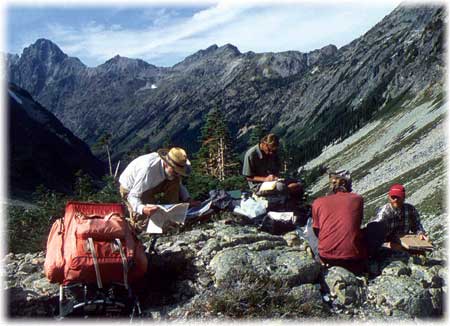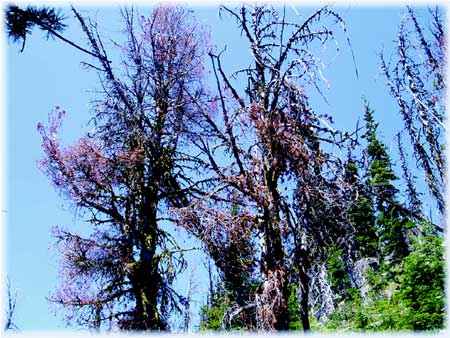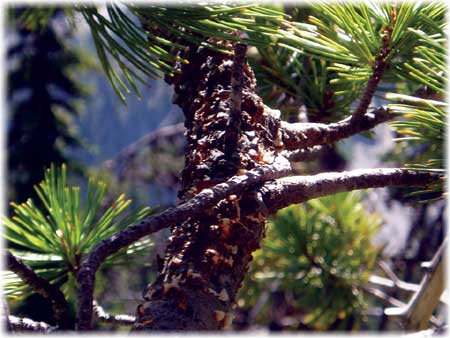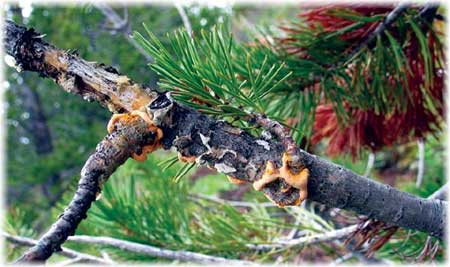|
PLANT ECOLOGY
Botanical Foray 2004
By Steve Hahn, NPS Biological Technician
The mountains of the North Cascades are
home to well over 1,000 species of vascular plants, but no one knows
just how many, not even in the national park. This summer marked the
third year that the North Cascades National Park Service Complex has
worked with the Herbarium staff at the University of Washington to
collect vascular plants in the park. Vascular plants are those which
have structures that conduct water, nutrients and photosynthetic
material. Plants that reproduce by seeds are vascular plants, while
things such as mosses are not. We have dubbed these collecting
expeditions "botanical forays".
The Natural Resource Challenge requires
national parks to verify that at least 90% of the vascular plants on
their existing plant lists are, in fact, present in the park. Before now
there was no quality standard for these important inventories of the
plants which national parks are to protect. The botanical forays began
as part of an effort to provide this verification at North Cascades
National Park. The first year we surveyed 3 areas: Colonial Creek
Campground/Lower Thunder Basin, Lightning Creek/Desolation Trail/Little
Beaver and Cascade Pass/Pelton Basin. In 2003 the surveys focused on the
Fisher Basin area.


Steve Hahn (writing) with volunteers
pressing botanical samples in Fisher Basin.
|
This year's foray was conducted in the
southeast portion of the park complex and included McAlester Mountain,
Dee Dee Lakes, McAlester Lake, High Pass and Rainbow Ridge. This area
was chosen because we knew that very little botanizing and no plant
collecting had been attempted there in the past. Two botanists
representing the Park Service and the University of Washington led 8
talented and dedicated volunteer botanists in the field work. We
established a base camp at McAlester Lake for the 4 days of collecting
and plant pressing. For the first time, we had the help of the park's
pack horses and mules to carry the heavy and awkward drying presses into
the remote backcountry.
In 4 days the group collected approximately
335 specimens from 31 plant families, 70 genera and a wide variety of
habitats. Preliminary results indicate that we found 3 very noteworthy
specimens, including 2 new locations for plants designated as
"Sensitive" and one range extension. The Washington Natural Heritage
Program lists the 2 species of Sensitive Plants as "S1", which denotes a
critically imperiled population with 5 or fewer known occurrences in the
state! The finding of the third species represents its furthest known
southern occurrence. All 3 of these plants are more common north of the
park complex, suggesting that the park may be home to the southernmost
known populations of these plants. Populations at the edge of a plant's
range often harbor unique and important genetic variation relative to
the main populations. These discoveries highlight the importance of
surveying for vascular plants and of organizing a group of knowledgeable
botanists to complete the task. These plants are part of what make North
Cascades National Park so special and significant. A more complete
understanding of their presence helps park managers to ensure their
long-term protection.


Whitebark pine with dead tops from
girdling by blister rust cankers.
|
Key High Elevation Pine Threatened Across
The West
By Regina Rochefort, NPS Science
Advisor
Whitebark pine is a species of central
importance in the high-elevation ecosystems of Western North America. It
begins growing on windswept ridges and in subalpine areas (5,000
7,000 or more feet) after fires. Its establishment in this harsh
environment creates a micro-habitat for other species of plants and
animals, as well as providing a food source for many species including
grizzly bears and a bird called the Clark's Nutcracker.
Today, the long-term survival of this tree is
uncertain due to the introduction of a Eurasian fungus called blister
rust to North America in 1910. As the rust spreads through the tree,
it produces cankers which restrict the flow of sap and can girdle the
tree. The sweet cankers also attract unwanted visitors such as harmful
rodents. In the late 1980's whitebark pine surveys in Glacier National
Park, documented mortality from blister rust exceeding 90%. While the
future of whitebark pine does not appear as bleak in the Cascades as in
Glacier National Park blister rust does pose a serious threat to the
survival of our whitebark pine populations.
Between 1994 and 1999, we surveyed Mount
Rainier and North Cascades National Parks to determine the status of
whitebark pine populations. Although the evidence is that infection and
mortality rates are highly variable in both parks, blister rust was
present in 97% of the stands we examined. On average, 22% of all the
whitebark pines had blister rust and 34% of them were dead. We also
found that about 25% of all seedlings and saplings were infected, and
10% were dead. Interestingly, infection rates increased from west to
east and with increasing elevation.
In 2003, National Parks in the Pacific
Northwest received funding for a two year project to survey the genetic
diversity of whitebark pine, begin investigating resistance of local
populations to blister, and establish permanent plots to monitor the
status of the tree's population over time. Monitoring permanent plots
will help us determine if rates of mortality are changing, what percent
of the trees might be resistant to blister rust, and if seedlings are
surviving. This information will help develop long-term protection
strategies for this important high-elevation species.


Whitebark pine with blister rust
cankers.


|
Over the past two years, we collected pine
needles for genetic analysis from 9 whitebark populations in North
Cascades National Park, 10 populations in Mount Rainier National Park,
and 5 populations in Olympic National Park. The U.S. Forest Service's
National Forest Genetics Laboratory in Riverside, California, is doing
the genetic analysis. These data will give us an idea of how much
populations differ within and between the national parks. If it is
determined that restoration (planting of trees or seeds) is necessary
to protect this species, we will use the data to
develop guidelines for how far seeds can be planted from collection
sites.
During summer 2004, we established permanent
monitoring plots in North Cascades and Mount Rainier National Parks.
After discussion with staff from Crater Lake and Yellowstone National
Parks and using methods developed by the Whitebark Pine Foundation, we
are designing monitoring methods. Crews from North Cascades and Mount
Rainier worked together on sites in each park to ensure
consistency.
Long-term survival of the Whitebark pine
population will depend on the production of seeds and blister rust
resistant offspring, the presence of safe sites for regeneration, and
the general health of the ecosystem. Long-term monitoring and research
will provide us with an accurate picture of the status of populations
and a better understanding of the ecology of this important
high-elevation species.
|
